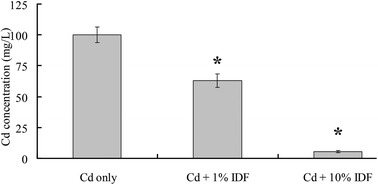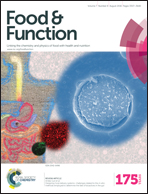Wheat bran intake can attenuate chronic cadmium toxicity in mice gut microbiota
Abstract
Environmental exposure to pollutants such as heavy metals is responsible for various altered physiological functions that are detrimental to health. Cadmium (Cd) is one of the most representative toxic, non-essential elements that can contaminate food and water. This study evaluated the protective effects of wheat bran, a selected prebiotic with good Cd binding ability, against Cd toxicity in mice. Thirty mice were divided into control and therapeutic groups. The control group was fed a low dietary fiber diet with no Cd for 8 weeks. In the therapeutic group, 100 mg L−1 Cd was administered along with a diet of 10% wheat bran. First, the binding ability of wheat bran for Cd was measured along with the protection of cell growth in vitro by wheat bran. Second, the effectiveness of wheat bran in preventing Cd from entering mice organs was evaluated. Finally, restoration of gut microbiota from alterations caused by Cd was investigated. The results showed that wheat bran could bind most of the Cd ions and restore the growth rate of cells in vitro. The wheat bran treatment group showed that the bran effectively prevented Cd from entering mice organs. In addition, the bacterial community structure was restored because the toxicity of Cd to gut microbiota was eliminated by the wheat bran. Our results suggest that wheat bran is more effective against chronic Cd toxicity than traditional treatments because of its special physiological functions, and it can be considered as a new dietary, therapeutic strategy against Cd toxicity.

- This article is part of the themed collection: Probiotics, Prebiotics and Gut Health

 Please wait while we load your content...
Please wait while we load your content...